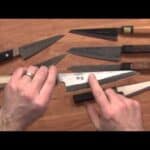Is boning knife necessary? Well, a good quality boning knife will save you money in the long run, especially if you work with larger pieces of meat. Whenever I buy whole chickens or a quarter of a cow, I can’t imagine not having a boning knife. In case you are looking for best boning knife, we have recommendation for you!
There are some who say you can debone a chicken with your chef’s knife, but I would recommend against it. You should use it very carefully and understand what you are doing. I made the same mistake and chipped the edge of my expensive chefs knife upon hitting a bone.
Those interested in butchering meat need a boning knife more than others. When preparing tough cuts of beef or venison with only the most rudimentary kitchen equipment, subpar results are often achieved. Ordinary chefs’ knives are not designed to cut through joints or connective tissue, wasting the best cuts of meat and damaging your expensive knives.
I use a boning knife which helps me mostly for cutting whole chickens and large pieces of beef. Usually, I buy 10 or 15 whole chickens from the farmer or 1/4 of a cow, and I couldn’t imagine cutting ribeye, loin or shank without a boning knife. Even if I hit a bone or cut a joint too high, it really doesn’t matter because a boning knife is meant to hit a bone occasionally.
Is Boning Knife Necessary: When and why should you get one?
When deboning a lot of poultry, meat, or ribs, or when filleting fish. A boning knife is worth the expense if you are frequently deboning poultry, meat, or filleting fish. Aside from making the often-irritating process a breeze, its flexibility and shape can also help you harvest the most flavorful meat close to the bone.
You want to improve the presentation of your meat. With a standard chef’s knife, you often end up hacking expensive cuts into pieces when deboning, deskinning, paring, and butchering. A good boning knife will allow you to make smoother, straighter cuts to improve the presentation of your dishes.
Meat is trimmed when it is cut into smaller pieces. Around the globe, butchers use boning knives to cut sides of beef or quarter chickens.
Your other knives are frequently damaged or blunted. It is easier to debone with a boning knife, and it will preserve your other knives as well. Deboning knives are designed specifically for the job, which means the corners of your chef’s knife won’t be subjected to the same stress and strain as they would when removing bones from a chicken.
Is Boning Knife Necessary: When Don’t I Need One?
When butchering animal carcasses, you are looking for harder types of bone and cartilage. The blades of boning knives are not as thick as those of cleavers, meaning that they do not cut through harder types of bone and cartilage.
You already have another knife that does the job, or you do not often handle meat cuts. Even if you already own a chef’s knife and a fillet knife, there are a few common kitchen tasks you could only perform with an additional deboning knife. Although it has many more uses, it likely won’t be worth the investment if you don’t often handle raw meat.
Is Boning Knife Necessary: What does a Boning Knife Do
There are two types of boning knives: long knives with thin blades and knives with narrow blades. Long knives are commonly 5″ or 7″. Its sharp edges and slight curve make it very useful for removing meat, poultry, and fish’s skin and bones.
Boning knives come in three types: stiff, flexible, and semi-flexible.
Pork and beef are tough meats that require boning knives to be trimmed. In addition to filleting fish, large fish like salmon and tuna are also commonly processed using such tools. When exerting force on joints, ligaments, and connective tissue, a stiff boning knife will not bend so easily.
Knives for boning are flexible and meant for softer cuts of meat, such as poultry and smaller fish. Additionally, they allow for more flexibility in the kitchen.
A semi-flexible boning knife offers strength and dexterity in one – the strength to handle a large piece of meat like beef or pork with the dexterity to effectively handle ribs.
Pros and Cons of a Boning Knife
Boning knives can provide several benefits. They may be used in the following ways: Boning knives of good quality feature a rigid blade that keeps its sharpness for a longer period of time, allowing you to make smooth cuts even through the most challenging beef joint.
The best tasting meat does not go to waste with boning knives, which get closer to the bone than chefs’ knives and make sure all the meat you cut is preserved and presented well.
It is also important to consider the following disadvantages:
The use of a flexible boning knife on thicker cuts of meat can cause damage to your knife and, more importantly, injury to yourself. Chopping bone or tough cartilage with a boning knife is equally dangerous. Additionally, using a knife that is too long – such as a large boning knife for an intricate task – can also result in a loss of control.
When filleting fish exclusively, a fillet knife will be more useful. The fillet knife is a type of boning knife that is much smaller and more flexible, making it easier to cut through tender fish meat.
Was this helpful?
Hi there! I’m a food enthusiast and journalist, and I have a real passion for food that goes beyond the kitchen. I love my dream job and I’m lucky enough to be able to share my knowledge with readers of several large media outlets. My specialty is writing engaging food-related content, and I take pride in being able to connect with my audience. I’m known for my creativity in the kitchen, and I’m confident that I can be the perfect guide for anyone looking to take their culinary journey to the next level.









